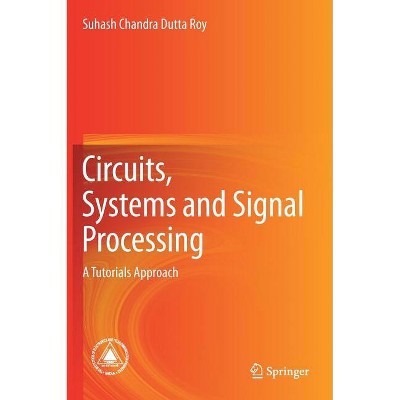Sponsored

Synchronization and Arbitration in Digital Systems - by David J Kinniment (Hardcover)
In Stock
Sponsored
About this item
Highlights
- Today's networks of processors on and off chip, operating with independent clocks, need effective synchronization of the data passing between them for reliability.
- About the Author: David Kinniment is Professor Emeritus at the University of Newcastle, having been Professor of Electronics in the Department of Electrical, Electronic and Computer Engineering from 1979 until 1998.
- 280 Pages
- Technology, Electronics
Description
Book Synopsis
Today's networks of processors on and off chip, operating with independent clocks, need effective synchronization of the data passing between them for reliability. When two or more processors request access to a common resource, such as a memory, an arbiter has to decide which request to deal with first. Current developments in integrated circuit processing are leading to an increase in the numbers of independent digital processing elements in a single system. With this comes faster communications, more networks on chip, and the demand for more reliable, more complex, and higher performance synchronizers and arbiters. Written by one of the foremost researchers in this area of digital design, this authoritative text provides in-depth theory and practical design solutions for the reliable working of synchronization and arbitration hardware in digital systems.The book provides methods for making real reliability measurements both on and off chip, evaluating some of the common difficulties and detailing circuit solutions at both circuit and system levels. Synchronization and Arbitration in Digital Systems also presents:
- mathematical models used to estimate mean time between failures in digital systems;
- a summary of serial and parallel communication techniques for on-chip data transmission;
- explanations on how to design a wrapper for a locally synchronous cell, highlighting the issues associated with stoppable clocks;
- an examination of various types of priority arbiters, using signal transition graphs to show the specification of different designs (from the simplest to more complex multi-way arbiters) including ways of solving problems encountered in a wide range of applications;
- essential information on systems composed of independently timed regions, including a discussion on the problem of choice and the factors affecting the time taken to make choices in electronics.
With its logical approach to design methodology, this will prove an invaluable guide for electronic and computer engineers and researchers working on the design of digital electronic hardware. Postgraduates and senior undergraduate students studying digital systems design as part of their electronic engineering course will struggle to find a resource that better details the information given inside this book
From the Back Cover
Title: Synchronization and Arbitration in Digital SystemsAuthor: David J. Kinniment, University of Newcastle, U.K.
Today's networks of processors on and off chip, operating with independent clocks, need effective synchronization of the data passing between them for reliability. When two or more processors request access to a common resource, such as a memory, an arbiter has to decide which request to deal with first.
Current developments in integrated circuit processing are leading to an increase in the numbers of independent digital processing elements in a single system. With this comes faster communications, more networks on chip, and the demand for more reliable, more complex, and higher performance synchronizers and arbiters.
Written by one of the foremost researchers in this area of digital design, this authoritative text provides in-depth theory and practical design solutions for the reliable working of synchronization and arbitration hardware in digital systems.
The book provides methods for making real reliability measurements both on and off chip, evaluating some of the common difficulties and detailing circuit solutions at both circuit and system levels. Synchronization and Arbitration in Digital Systems also presents:
mathematical models used to estimate mean time between failures in digital systems;
a summary of serial and parallel communication techniques for on-chip data transmission;
explanations on how to design a wrapper for a locally synchronous cell, highlighting the issues associated with stoppable clocks;
an examination of various types of priority arbiters, using signal transition graphs to show the specification of different designs (from the simplest to more complex multi-way arbiters) including ways of solving problems encountered in a wide range of applications;
essential information on systems composed of independently timed regions, including a discussion on the problem of choice and the factors affecting the time taken to make choices in electronics.
With its logical approach to design methodology, this will prove an invaluable guide for electronic and computer engineers and researchers working on the design of digital electronic hardware. Postgraduates and senior undergraduate students studying digital systems design as part of their electronic engineering course will struggle to find a resource that better details the information given inside this book.
About the Author
David Kinniment is Professor Emeritus at the University of Newcastle, having been Professor of Electronics in the Department of Electrical, Electronic and Computer Engineering from 1979 until 1998. He currently works part time, mainly on asynchronous design and design methodology, in the Computer Science Department. He is very experienced in the measurement and characterization of synchronization and arbitration in digital systems, having been one of the leading researchers in the world in this area of digital design since the 1970s. He wrote the first paper to describe the measurement of mean time between failures (in other words, realiability) for a metastable device in 1972 and this year (2006) he won the best paper award at the ASYNC 2006 conference. Along with this, he has written a number of published journal articles on the topic, and has also collaborated with industry (most recently INTEL) to develop efficient digital hardware design methods, and ways of ensuring reliability in digital processors.Shipping details
Return details
Trending Computers & Technology Books


















